Critical Appraisal of Mazda's Competitive Position & Strategy
VerifiedAdded on 2023/06/11
|23
|4578
|67
Report
AI Summary
This report provides a comprehensive analysis of Mazda's business strategy, benchmarking its competitive position against industry leaders Toyota and Honda. It examines Mazda's background, rationale for analysis, key issues such as market share decline and customer complaints, and conducts a strategic analysis using PESTEL and Porter's Five Forces. The report also evaluates Mazda's financial performance through ratios like current ratio, gross profit margin, net profit margin, and return on capital employed. Limitations of both strategic and financial analyses are discussed. The report concludes with recommendations and potential strategy directions for Mazda to improve its competitive standing and increase market share, referencing Bowman’s strategy clock for strategic positioning.

Running Header: Business Analysis
Paraphrase This Document
Need a fresh take? Get an instant paraphrase of this document with our AI Paraphraser
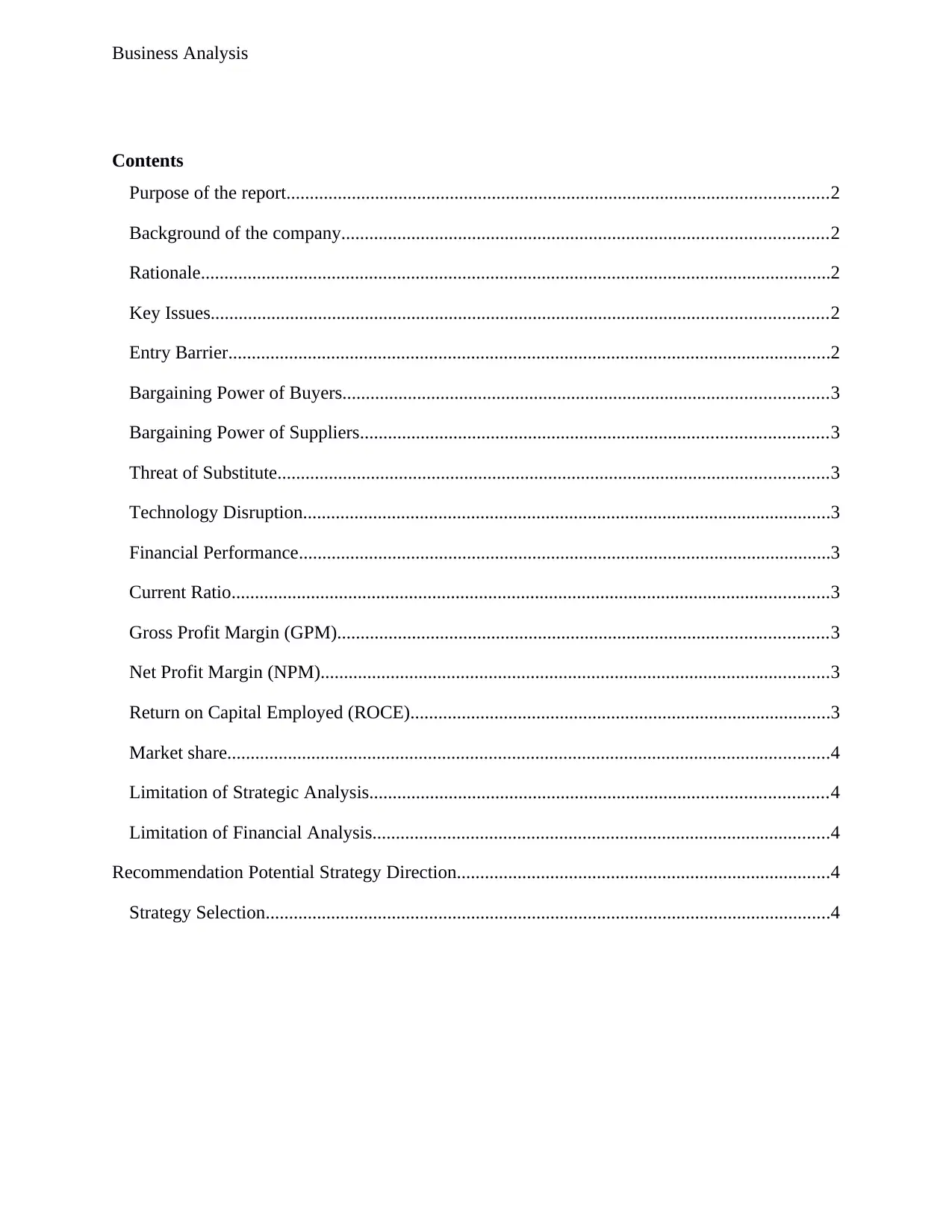
Business Analysis
Contents
Purpose of the report....................................................................................................................2
Background of the company........................................................................................................2
Rationale.......................................................................................................................................2
Key Issues....................................................................................................................................2
Entry Barrier.................................................................................................................................2
Bargaining Power of Buyers........................................................................................................3
Bargaining Power of Suppliers....................................................................................................3
Threat of Substitute......................................................................................................................3
Technology Disruption.................................................................................................................3
Financial Performance..................................................................................................................3
Current Ratio................................................................................................................................3
Gross Profit Margin (GPM).........................................................................................................3
Net Profit Margin (NPM).............................................................................................................3
Return on Capital Employed (ROCE)..........................................................................................3
Market share.................................................................................................................................4
Limitation of Strategic Analysis..................................................................................................4
Limitation of Financial Analysis..................................................................................................4
Recommendation Potential Strategy Direction................................................................................4
Strategy Selection.........................................................................................................................4
Contents
Purpose of the report....................................................................................................................2
Background of the company........................................................................................................2
Rationale.......................................................................................................................................2
Key Issues....................................................................................................................................2
Entry Barrier.................................................................................................................................2
Bargaining Power of Buyers........................................................................................................3
Bargaining Power of Suppliers....................................................................................................3
Threat of Substitute......................................................................................................................3
Technology Disruption.................................................................................................................3
Financial Performance..................................................................................................................3
Current Ratio................................................................................................................................3
Gross Profit Margin (GPM).........................................................................................................3
Net Profit Margin (NPM).............................................................................................................3
Return on Capital Employed (ROCE)..........................................................................................3
Market share.................................................................................................................................4
Limitation of Strategic Analysis..................................................................................................4
Limitation of Financial Analysis..................................................................................................4
Recommendation Potential Strategy Direction................................................................................4
Strategy Selection.........................................................................................................................4
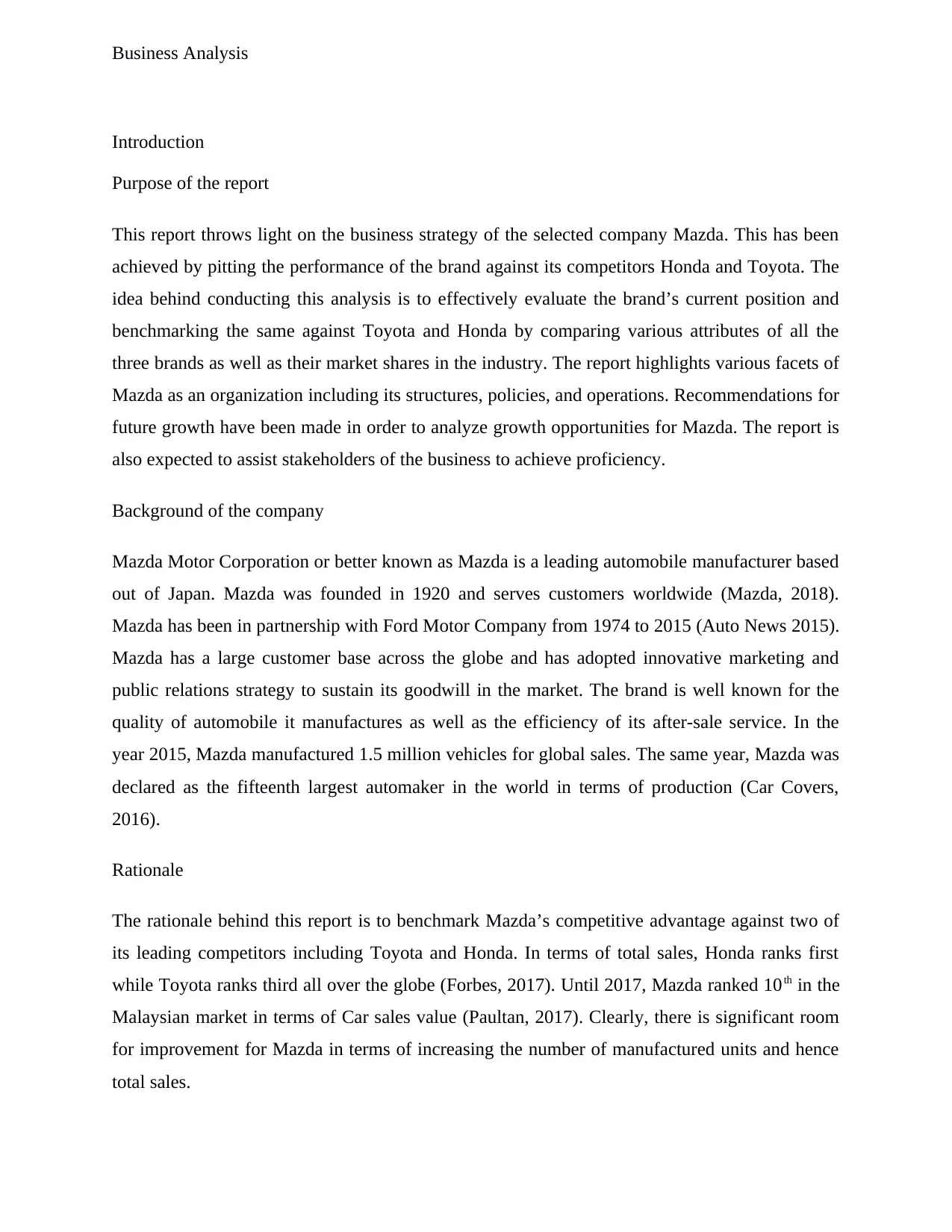
Business Analysis
Introduction
Purpose of the report
This report throws light on the business strategy of the selected company Mazda. This has been
achieved by pitting the performance of the brand against its competitors Honda and Toyota. The
idea behind conducting this analysis is to effectively evaluate the brand’s current position and
benchmarking the same against Toyota and Honda by comparing various attributes of all the
three brands as well as their market shares in the industry. The report highlights various facets of
Mazda as an organization including its structures, policies, and operations. Recommendations for
future growth have been made in order to analyze growth opportunities for Mazda. The report is
also expected to assist stakeholders of the business to achieve proficiency.
Background of the company
Mazda Motor Corporation or better known as Mazda is a leading automobile manufacturer based
out of Japan. Mazda was founded in 1920 and serves customers worldwide (Mazda, 2018).
Mazda has been in partnership with Ford Motor Company from 1974 to 2015 (Auto News 2015).
Mazda has a large customer base across the globe and has adopted innovative marketing and
public relations strategy to sustain its goodwill in the market. The brand is well known for the
quality of automobile it manufactures as well as the efficiency of its after-sale service. In the
year 2015, Mazda manufactured 1.5 million vehicles for global sales. The same year, Mazda was
declared as the fifteenth largest automaker in the world in terms of production (Car Covers,
2016).
Rationale
The rationale behind this report is to benchmark Mazda’s competitive advantage against two of
its leading competitors including Toyota and Honda. In terms of total sales, Honda ranks first
while Toyota ranks third all over the globe (Forbes, 2017). Until 2017, Mazda ranked 10th in the
Malaysian market in terms of Car sales value (Paultan, 2017). Clearly, there is significant room
for improvement for Mazda in terms of increasing the number of manufactured units and hence
total sales.
Introduction
Purpose of the report
This report throws light on the business strategy of the selected company Mazda. This has been
achieved by pitting the performance of the brand against its competitors Honda and Toyota. The
idea behind conducting this analysis is to effectively evaluate the brand’s current position and
benchmarking the same against Toyota and Honda by comparing various attributes of all the
three brands as well as their market shares in the industry. The report highlights various facets of
Mazda as an organization including its structures, policies, and operations. Recommendations for
future growth have been made in order to analyze growth opportunities for Mazda. The report is
also expected to assist stakeholders of the business to achieve proficiency.
Background of the company
Mazda Motor Corporation or better known as Mazda is a leading automobile manufacturer based
out of Japan. Mazda was founded in 1920 and serves customers worldwide (Mazda, 2018).
Mazda has been in partnership with Ford Motor Company from 1974 to 2015 (Auto News 2015).
Mazda has a large customer base across the globe and has adopted innovative marketing and
public relations strategy to sustain its goodwill in the market. The brand is well known for the
quality of automobile it manufactures as well as the efficiency of its after-sale service. In the
year 2015, Mazda manufactured 1.5 million vehicles for global sales. The same year, Mazda was
declared as the fifteenth largest automaker in the world in terms of production (Car Covers,
2016).
Rationale
The rationale behind this report is to benchmark Mazda’s competitive advantage against two of
its leading competitors including Toyota and Honda. In terms of total sales, Honda ranks first
while Toyota ranks third all over the globe (Forbes, 2017). Until 2017, Mazda ranked 10th in the
Malaysian market in terms of Car sales value (Paultan, 2017). Clearly, there is significant room
for improvement for Mazda in terms of increasing the number of manufactured units and hence
total sales.
⊘ This is a preview!⊘
Do you want full access?
Subscribe today to unlock all pages.

Trusted by 1+ million students worldwide
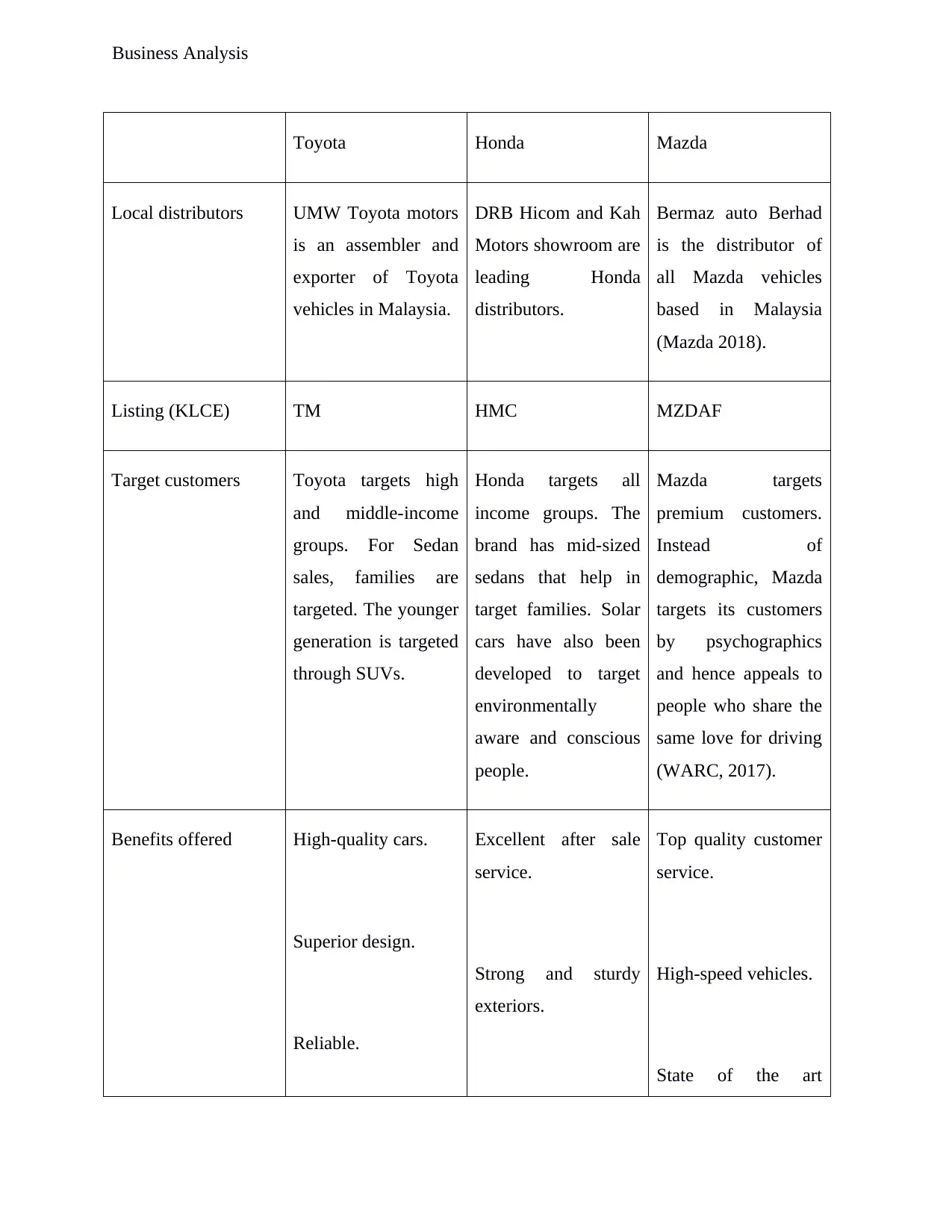
Business Analysis
Toyota Honda Mazda
Local distributors UMW Toyota motors
is an assembler and
exporter of Toyota
vehicles in Malaysia.
DRB Hicom and Kah
Motors showroom are
leading Honda
distributors.
Bermaz auto Berhad
is the distributor of
all Mazda vehicles
based in Malaysia
(Mazda 2018).
Listing (KLCE) TM HMC MZDAF
Target customers Toyota targets high
and middle-income
groups. For Sedan
sales, families are
targeted. The younger
generation is targeted
through SUVs.
Honda targets all
income groups. The
brand has mid-sized
sedans that help in
target families. Solar
cars have also been
developed to target
environmentally
aware and conscious
people.
Mazda targets
premium customers.
Instead of
demographic, Mazda
targets its customers
by psychographics
and hence appeals to
people who share the
same love for driving
(WARC, 2017).
Benefits offered High-quality cars.
Superior design.
Reliable.
Excellent after sale
service.
Strong and sturdy
exteriors.
Top quality customer
service.
High-speed vehicles.
State of the art
Toyota Honda Mazda
Local distributors UMW Toyota motors
is an assembler and
exporter of Toyota
vehicles in Malaysia.
DRB Hicom and Kah
Motors showroom are
leading Honda
distributors.
Bermaz auto Berhad
is the distributor of
all Mazda vehicles
based in Malaysia
(Mazda 2018).
Listing (KLCE) TM HMC MZDAF
Target customers Toyota targets high
and middle-income
groups. For Sedan
sales, families are
targeted. The younger
generation is targeted
through SUVs.
Honda targets all
income groups. The
brand has mid-sized
sedans that help in
target families. Solar
cars have also been
developed to target
environmentally
aware and conscious
people.
Mazda targets
premium customers.
Instead of
demographic, Mazda
targets its customers
by psychographics
and hence appeals to
people who share the
same love for driving
(WARC, 2017).
Benefits offered High-quality cars.
Superior design.
Reliable.
Excellent after sale
service.
Strong and sturdy
exteriors.
Top quality customer
service.
High-speed vehicles.
State of the art
Paraphrase This Document
Need a fresh take? Get an instant paraphrase of this document with our AI Paraphraser
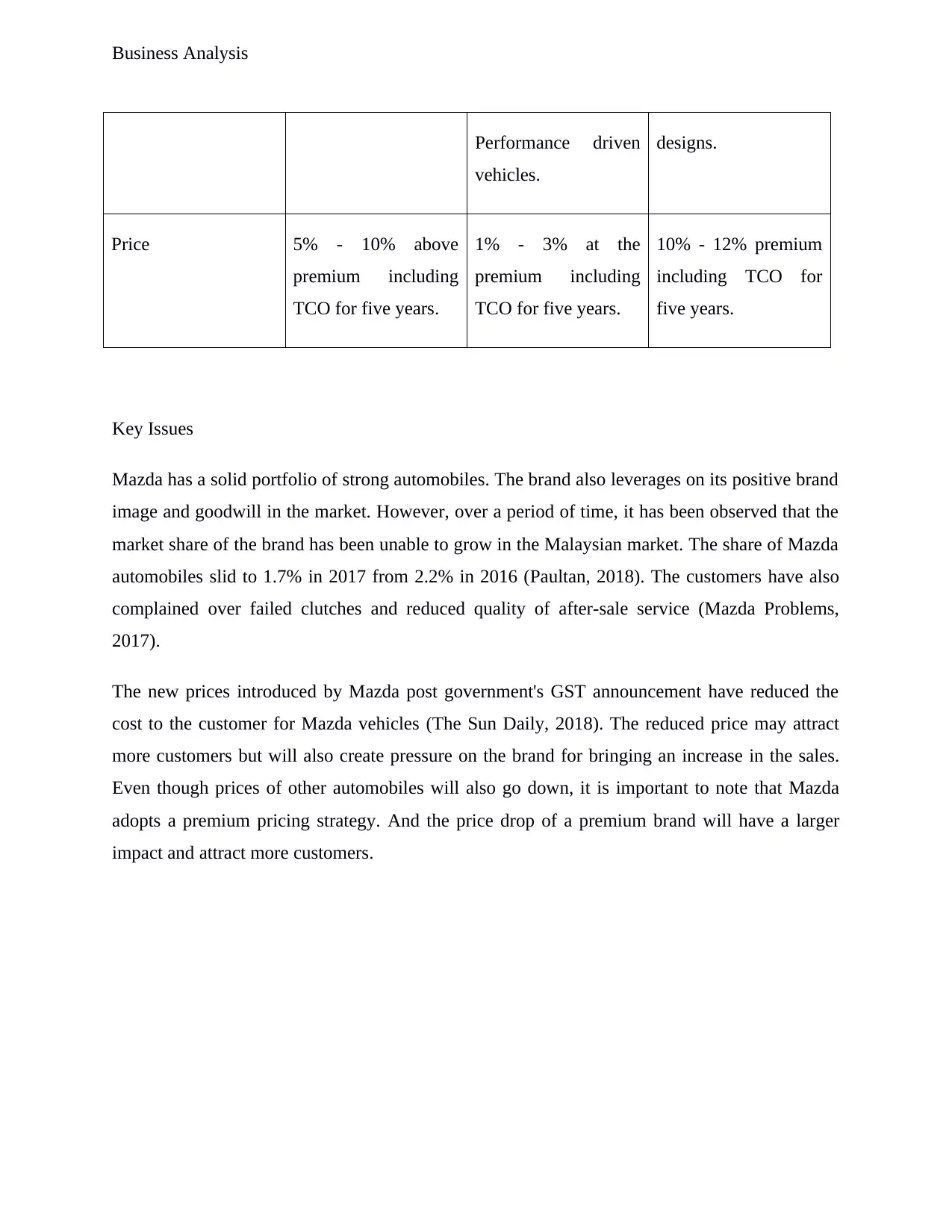
Business Analysis
Performance driven
vehicles.
designs.
Price 5% - 10% above
premium including
TCO for five years.
1% - 3% at the
premium including
TCO for five years.
10% - 12% premium
including TCO for
five years.
Key Issues
Mazda has a solid portfolio of strong automobiles. The brand also leverages on its positive brand
image and goodwill in the market. However, over a period of time, it has been observed that the
market share of the brand has been unable to grow in the Malaysian market. The share of Mazda
automobiles slid to 1.7% in 2017 from 2.2% in 2016 (Paultan, 2018). The customers have also
complained over failed clutches and reduced quality of after-sale service (Mazda Problems,
2017).
The new prices introduced by Mazda post government's GST announcement have reduced the
cost to the customer for Mazda vehicles (The Sun Daily, 2018). The reduced price may attract
more customers but will also create pressure on the brand for bringing an increase in the sales.
Even though prices of other automobiles will also go down, it is important to note that Mazda
adopts a premium pricing strategy. And the price drop of a premium brand will have a larger
impact and attract more customers.
Performance driven
vehicles.
designs.
Price 5% - 10% above
premium including
TCO for five years.
1% - 3% at the
premium including
TCO for five years.
10% - 12% premium
including TCO for
five years.
Key Issues
Mazda has a solid portfolio of strong automobiles. The brand also leverages on its positive brand
image and goodwill in the market. However, over a period of time, it has been observed that the
market share of the brand has been unable to grow in the Malaysian market. The share of Mazda
automobiles slid to 1.7% in 2017 from 2.2% in 2016 (Paultan, 2018). The customers have also
complained over failed clutches and reduced quality of after-sale service (Mazda Problems,
2017).
The new prices introduced by Mazda post government's GST announcement have reduced the
cost to the customer for Mazda vehicles (The Sun Daily, 2018). The reduced price may attract
more customers but will also create pressure on the brand for bringing an increase in the sales.
Even though prices of other automobiles will also go down, it is important to note that Mazda
adopts a premium pricing strategy. And the price drop of a premium brand will have a larger
impact and attract more customers.
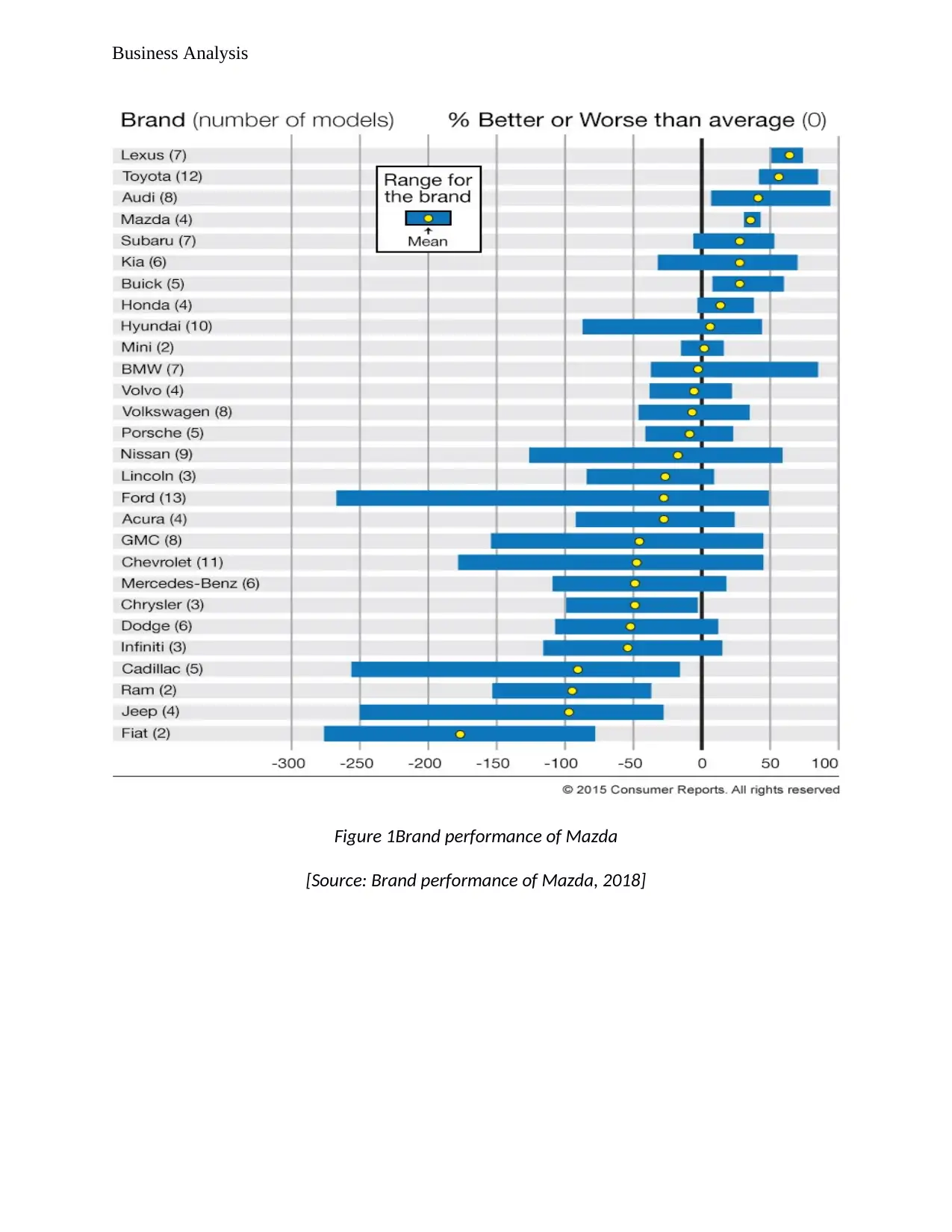
Business Analysis
Figure 1Brand performance of Mazda
[Source: Brand performance of Mazda, 2018]
Figure 1Brand performance of Mazda
[Source: Brand performance of Mazda, 2018]
⊘ This is a preview!⊘
Do you want full access?
Subscribe today to unlock all pages.

Trusted by 1+ million students worldwide
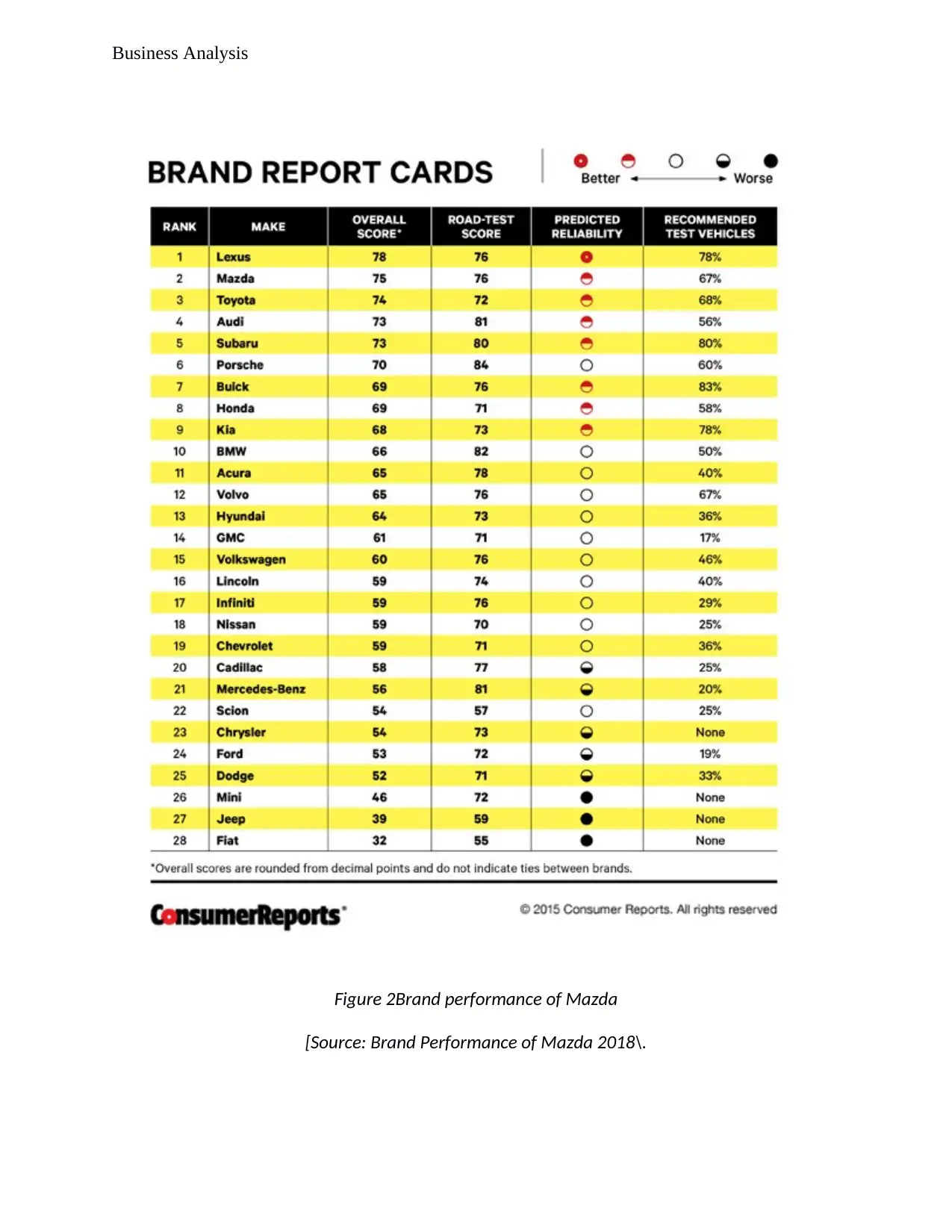
Business Analysis
Figure 2Brand performance of Mazda
[Source: Brand Performance of Mazda 2018\.
Figure 2Brand performance of Mazda
[Source: Brand Performance of Mazda 2018\.
Paraphrase This Document
Need a fresh take? Get an instant paraphrase of this document with our AI Paraphraser
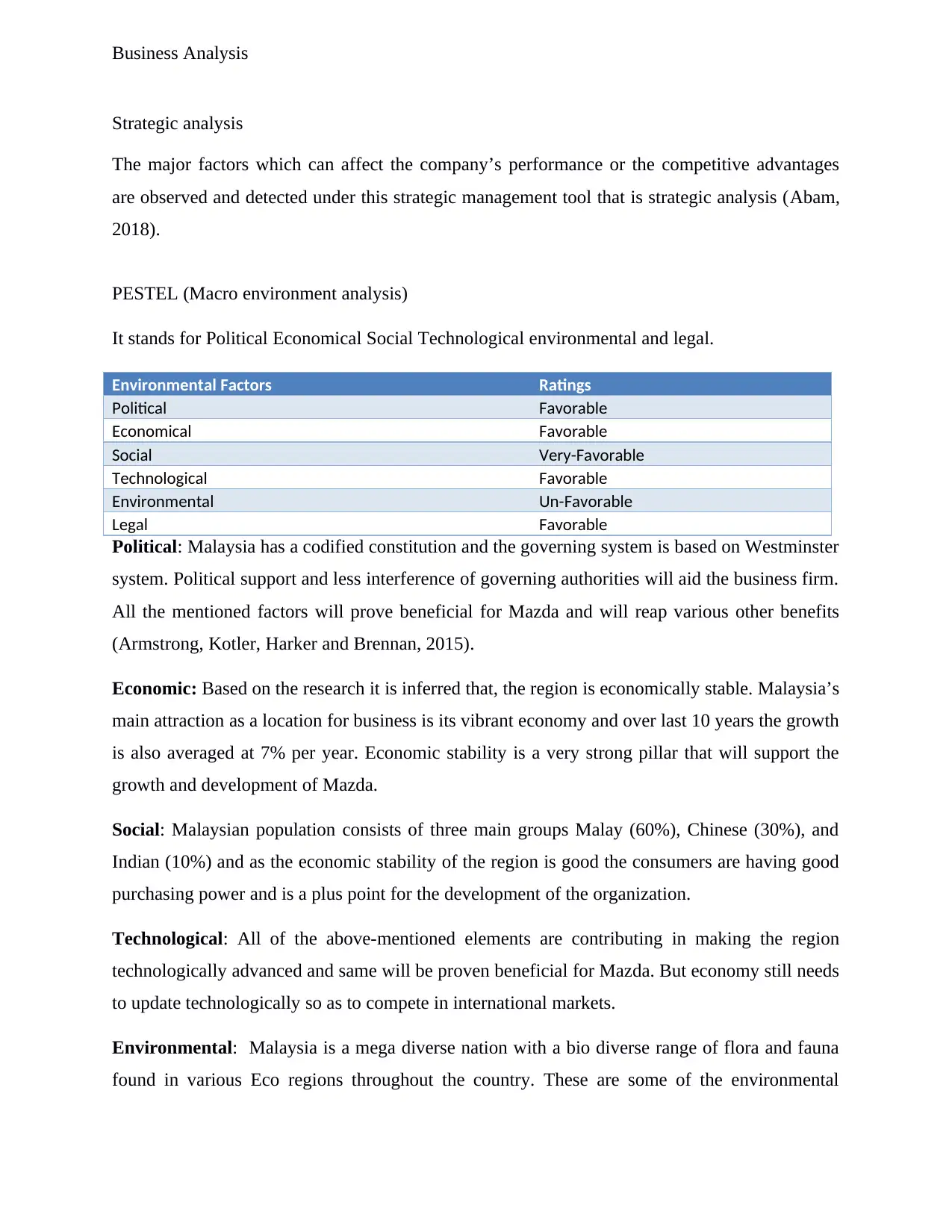
Business Analysis
Strategic analysis
The major factors which can affect the company’s performance or the competitive advantages
are observed and detected under this strategic management tool that is strategic analysis (Abam,
2018).
PESTEL (Macro environment analysis)
It stands for Political Economical Social Technological environmental and legal.
Environmental Factors Ratings
Political Favorable
Economical Favorable
Social Very-Favorable
Technological Favorable
Environmental Un-Favorable
Legal Favorable
Political: Malaysia has a codified constitution and the governing system is based on Westminster
system. Political support and less interference of governing authorities will aid the business firm.
All the mentioned factors will prove beneficial for Mazda and will reap various other benefits
(Armstrong, Kotler, Harker and Brennan, 2015).
Economic: Based on the research it is inferred that, the region is economically stable. Malaysia’s
main attraction as a location for business is its vibrant economy and over last 10 years the growth
is also averaged at 7% per year. Economic stability is a very strong pillar that will support the
growth and development of Mazda.
Social: Malaysian population consists of three main groups Malay (60%), Chinese (30%), and
Indian (10%) and as the economic stability of the region is good the consumers are having good
purchasing power and is a plus point for the development of the organization.
Technological: All of the above-mentioned elements are contributing in making the region
technologically advanced and same will be proven beneficial for Mazda. But economy still needs
to update technologically so as to compete in international markets.
Environmental: Malaysia is a mega diverse nation with a bio diverse range of flora and fauna
found in various Eco regions throughout the country. These are some of the environmental
Strategic analysis
The major factors which can affect the company’s performance or the competitive advantages
are observed and detected under this strategic management tool that is strategic analysis (Abam,
2018).
PESTEL (Macro environment analysis)
It stands for Political Economical Social Technological environmental and legal.
Environmental Factors Ratings
Political Favorable
Economical Favorable
Social Very-Favorable
Technological Favorable
Environmental Un-Favorable
Legal Favorable
Political: Malaysia has a codified constitution and the governing system is based on Westminster
system. Political support and less interference of governing authorities will aid the business firm.
All the mentioned factors will prove beneficial for Mazda and will reap various other benefits
(Armstrong, Kotler, Harker and Brennan, 2015).
Economic: Based on the research it is inferred that, the region is economically stable. Malaysia’s
main attraction as a location for business is its vibrant economy and over last 10 years the growth
is also averaged at 7% per year. Economic stability is a very strong pillar that will support the
growth and development of Mazda.
Social: Malaysian population consists of three main groups Malay (60%), Chinese (30%), and
Indian (10%) and as the economic stability of the region is good the consumers are having good
purchasing power and is a plus point for the development of the organization.
Technological: All of the above-mentioned elements are contributing in making the region
technologically advanced and same will be proven beneficial for Mazda. But economy still needs
to update technologically so as to compete in international markets.
Environmental: Malaysia is a mega diverse nation with a bio diverse range of flora and fauna
found in various Eco regions throughout the country. These are some of the environmental
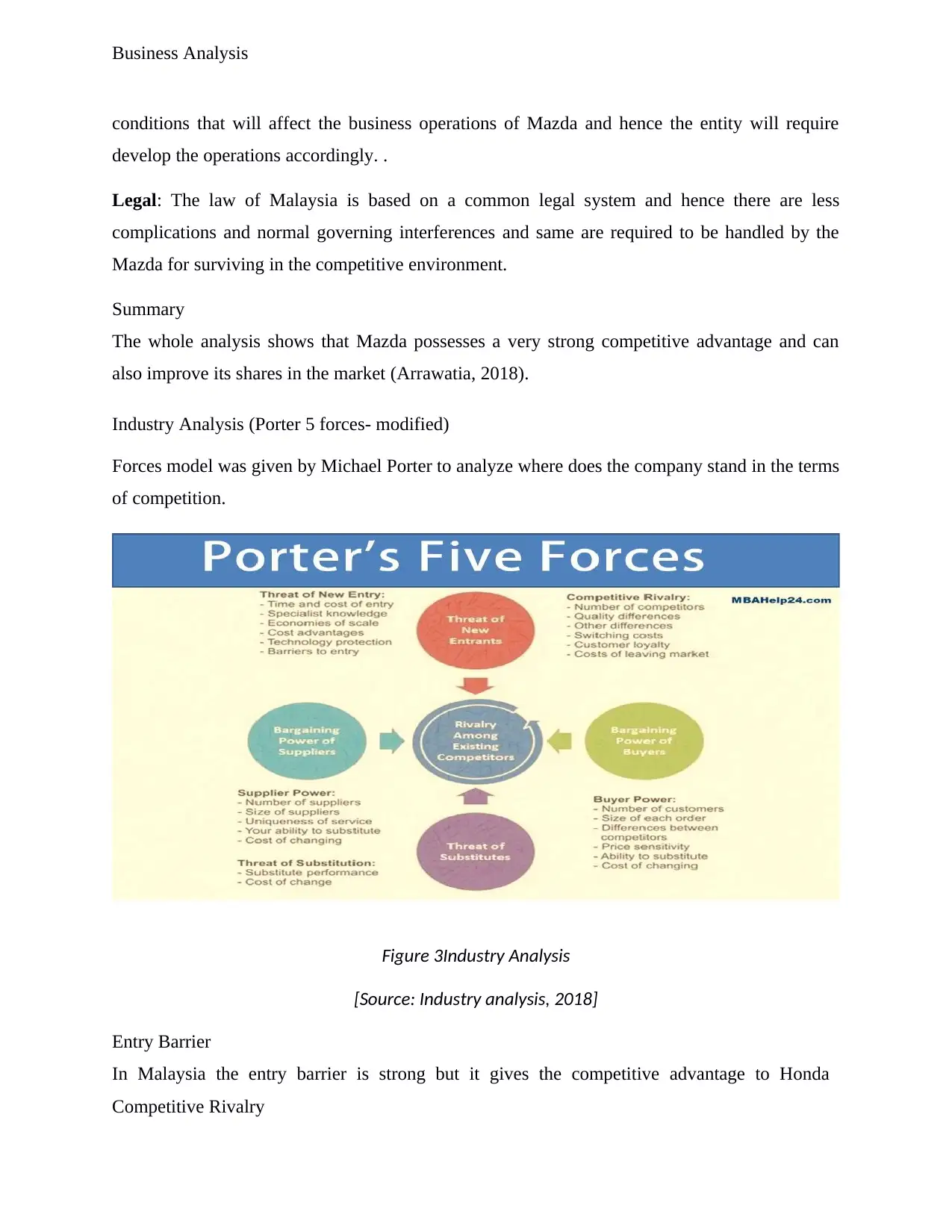
Business Analysis
conditions that will affect the business operations of Mazda and hence the entity will require
develop the operations accordingly. .
Legal: The law of Malaysia is based on a common legal system and hence there are less
complications and normal governing interferences and same are required to be handled by the
Mazda for surviving in the competitive environment.
Summary
The whole analysis shows that Mazda possesses a very strong competitive advantage and can
also improve its shares in the market (Arrawatia, 2018).
Industry Analysis (Porter 5 forces- modified)
Forces model was given by Michael Porter to analyze where does the company stand in the terms
of competition.
Figure 3Industry Analysis
[Source: Industry analysis, 2018]
Entry Barrier
In Malaysia the entry barrier is strong but it gives the competitive advantage to Honda
Competitive Rivalry
conditions that will affect the business operations of Mazda and hence the entity will require
develop the operations accordingly. .
Legal: The law of Malaysia is based on a common legal system and hence there are less
complications and normal governing interferences and same are required to be handled by the
Mazda for surviving in the competitive environment.
Summary
The whole analysis shows that Mazda possesses a very strong competitive advantage and can
also improve its shares in the market (Arrawatia, 2018).
Industry Analysis (Porter 5 forces- modified)
Forces model was given by Michael Porter to analyze where does the company stand in the terms
of competition.
Figure 3Industry Analysis
[Source: Industry analysis, 2018]
Entry Barrier
In Malaysia the entry barrier is strong but it gives the competitive advantage to Honda
Competitive Rivalry
⊘ This is a preview!⊘
Do you want full access?
Subscribe today to unlock all pages.

Trusted by 1+ million students worldwide
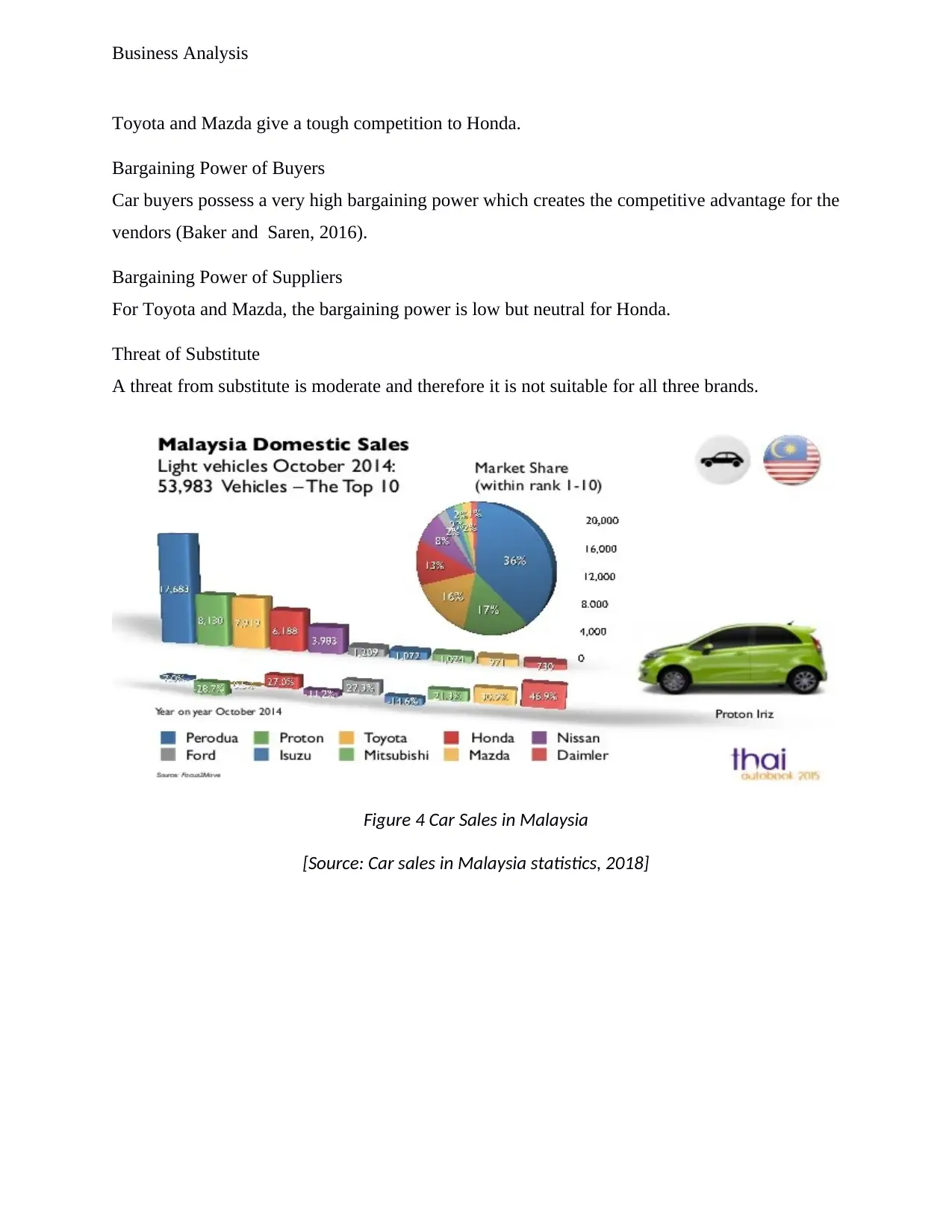
Business Analysis
Toyota and Mazda give a tough competition to Honda.
Bargaining Power of Buyers
Car buyers possess a very high bargaining power which creates the competitive advantage for the
vendors (Baker and Saren, 2016).
Bargaining Power of Suppliers
For Toyota and Mazda, the bargaining power is low but neutral for Honda.
Threat of Substitute
A threat from substitute is moderate and therefore it is not suitable for all three brands.
Figure 4 Car Sales in Malaysia
[Source: Car sales in Malaysia statistics, 2018]
Toyota and Mazda give a tough competition to Honda.
Bargaining Power of Buyers
Car buyers possess a very high bargaining power which creates the competitive advantage for the
vendors (Baker and Saren, 2016).
Bargaining Power of Suppliers
For Toyota and Mazda, the bargaining power is low but neutral for Honda.
Threat of Substitute
A threat from substitute is moderate and therefore it is not suitable for all three brands.
Figure 4 Car Sales in Malaysia
[Source: Car sales in Malaysia statistics, 2018]
Paraphrase This Document
Need a fresh take? Get an instant paraphrase of this document with our AI Paraphraser
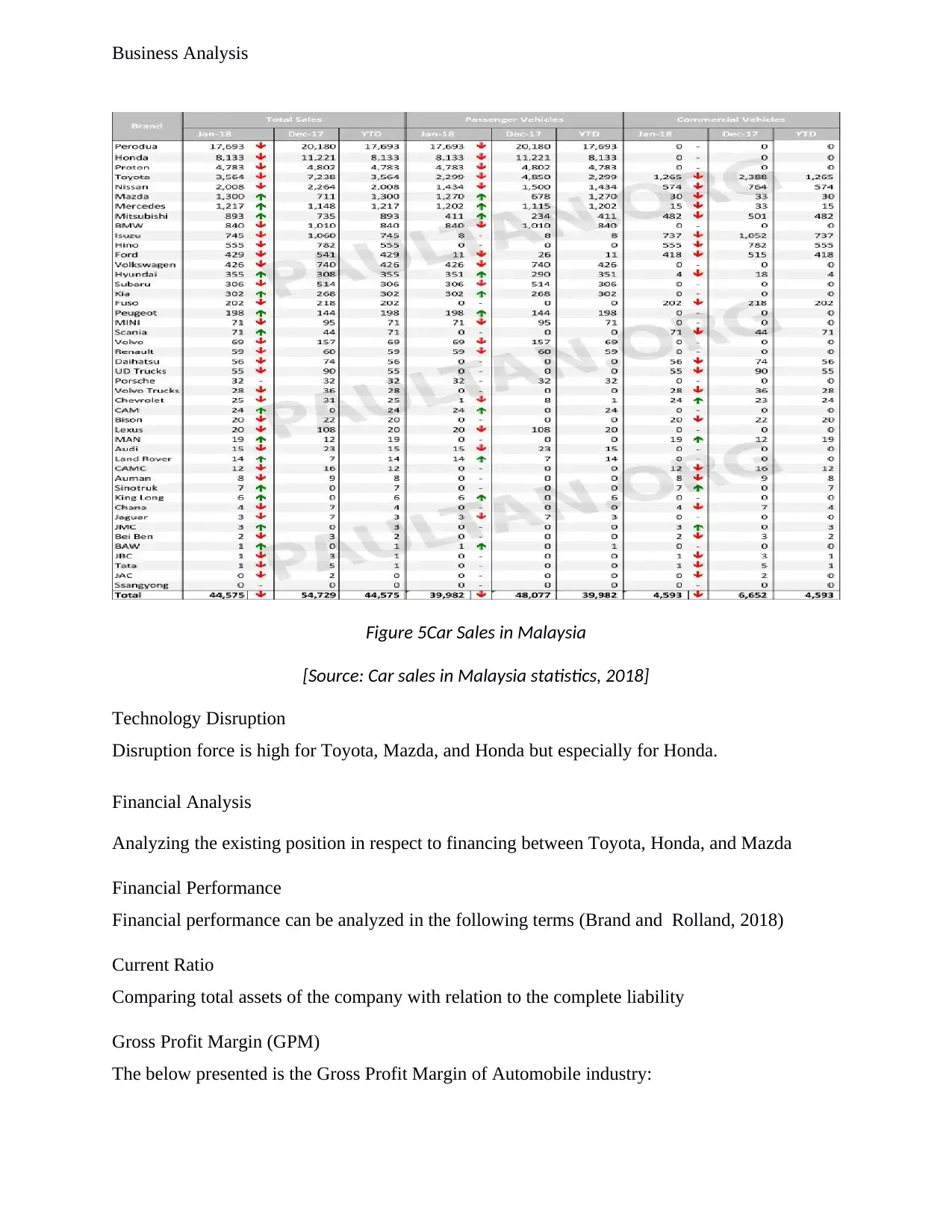
Business Analysis
Figure 5Car Sales in Malaysia
[Source: Car sales in Malaysia statistics, 2018]
Technology Disruption
Disruption force is high for Toyota, Mazda, and Honda but especially for Honda.
Financial Analysis
Analyzing the existing position in respect to financing between Toyota, Honda, and Mazda
Financial Performance
Financial performance can be analyzed in the following terms (Brand and Rolland, 2018)
Current Ratio
Comparing total assets of the company with relation to the complete liability
Gross Profit Margin (GPM)
The below presented is the Gross Profit Margin of Automobile industry:
Figure 5Car Sales in Malaysia
[Source: Car sales in Malaysia statistics, 2018]
Technology Disruption
Disruption force is high for Toyota, Mazda, and Honda but especially for Honda.
Financial Analysis
Analyzing the existing position in respect to financing between Toyota, Honda, and Mazda
Financial Performance
Financial performance can be analyzed in the following terms (Brand and Rolland, 2018)
Current Ratio
Comparing total assets of the company with relation to the complete liability
Gross Profit Margin (GPM)
The below presented is the Gross Profit Margin of Automobile industry:
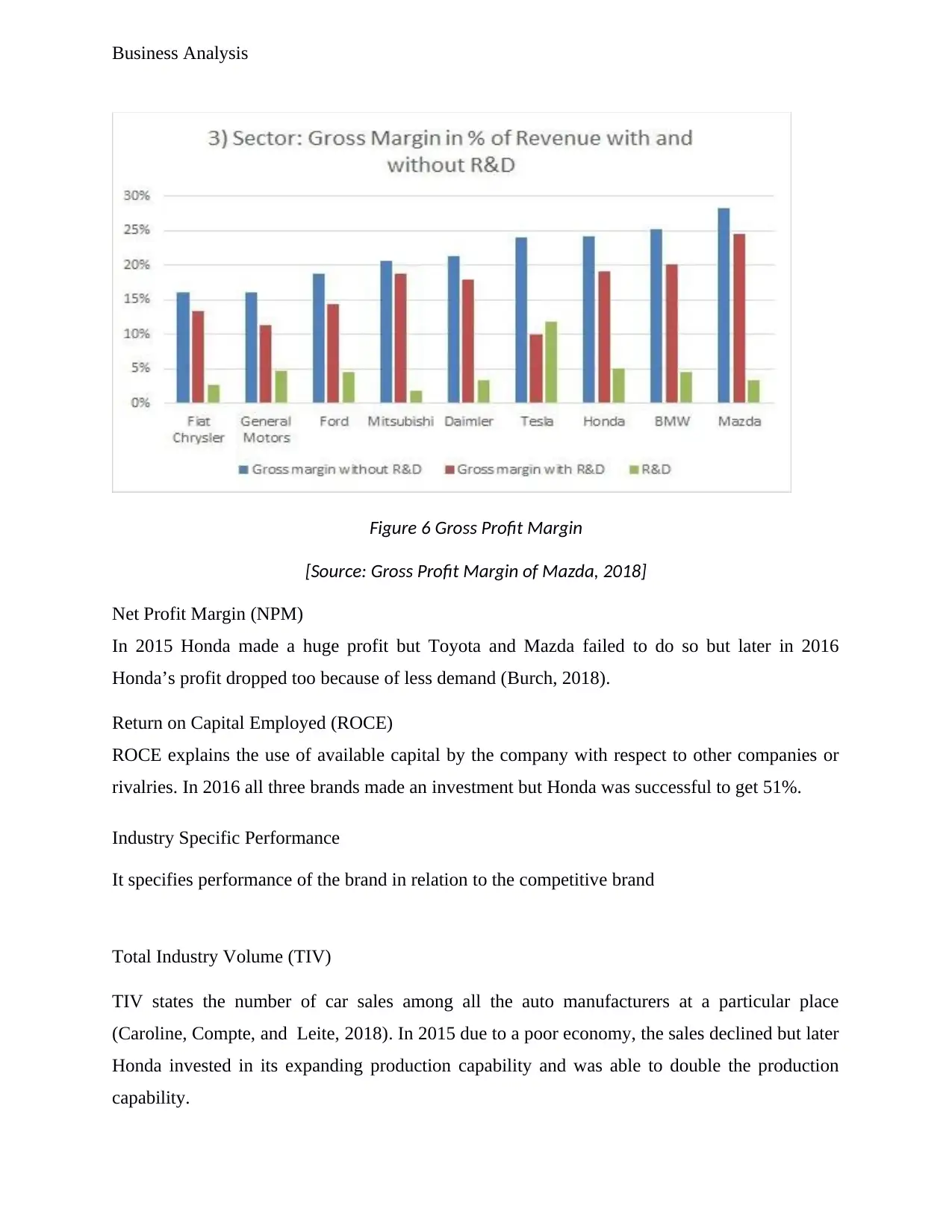
Business Analysis
Figure 6 Gross Profit Margin
[Source: Gross Profit Margin of Mazda, 2018]
Net Profit Margin (NPM)
In 2015 Honda made a huge profit but Toyota and Mazda failed to do so but later in 2016
Honda’s profit dropped too because of less demand (Burch, 2018).
Return on Capital Employed (ROCE)
ROCE explains the use of available capital by the company with respect to other companies or
rivalries. In 2016 all three brands made an investment but Honda was successful to get 51%.
Industry Specific Performance
It specifies performance of the brand in relation to the competitive brand
Total Industry Volume (TIV)
TIV states the number of car sales among all the auto manufacturers at a particular place
(Caroline, Compte, and Leite, 2018). In 2015 due to a poor economy, the sales declined but later
Honda invested in its expanding production capability and was able to double the production
capability.
Figure 6 Gross Profit Margin
[Source: Gross Profit Margin of Mazda, 2018]
Net Profit Margin (NPM)
In 2015 Honda made a huge profit but Toyota and Mazda failed to do so but later in 2016
Honda’s profit dropped too because of less demand (Burch, 2018).
Return on Capital Employed (ROCE)
ROCE explains the use of available capital by the company with respect to other companies or
rivalries. In 2016 all three brands made an investment but Honda was successful to get 51%.
Industry Specific Performance
It specifies performance of the brand in relation to the competitive brand
Total Industry Volume (TIV)
TIV states the number of car sales among all the auto manufacturers at a particular place
(Caroline, Compte, and Leite, 2018). In 2015 due to a poor economy, the sales declined but later
Honda invested in its expanding production capability and was able to double the production
capability.
⊘ This is a preview!⊘
Do you want full access?
Subscribe today to unlock all pages.

Trusted by 1+ million students worldwide
1 out of 23
Related Documents
Your All-in-One AI-Powered Toolkit for Academic Success.
+13062052269
info@desklib.com
Available 24*7 on WhatsApp / Email
![[object Object]](/_next/static/media/star-bottom.7253800d.svg)
Unlock your academic potential
Copyright © 2020–2025 A2Z Services. All Rights Reserved. Developed and managed by ZUCOL.





